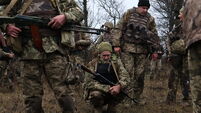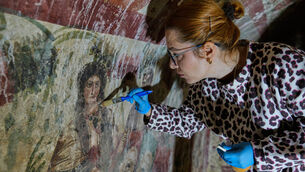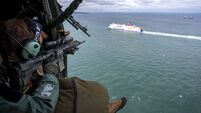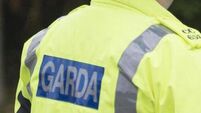‘Medically inexplicable’ survival of girl rescued after 15 days
Hundreds of thousands of other survivors hoped for a breakthrough of another kind – the delivery of badly needed food aid.
Key players in the Haiti earthquake relief effort, in what may prove to be a pivotal meeting, decided tocoordinate better by dividing up the shattered capital, giving each responsibility for handing out food in certain areas.
Food distribution so far has often been marked by poor coordination, vast gaps in coverage, and desperate, unruly lines of needy people in which young men at times shoved aside the women and weak and took their food.
“These things should be done in a systematic way, not a random way,” Dr Eddy Delalue, who runs a Haitian relief group, Operation Hope, said of the emergency food programme. “It’s survival of the fittest: The strongest guy gets it.”
The rescue of teenager Darlene Etienne from a collapsed home near St Gerard University, 15 days after Haiti’s great quake killed an estimated 200,000 people, was the first such recovery since Saturday, when French rescuers extricated a man from the ruins of a hotel grocery store. A man pulled on Tuesday from the rubble of a downtown store said he had been trapped during an aftershock, not in the original January 12 quake.
Etienne is stable, and has been drinking water and eating yoghurt and mashed vegetables, said Dr Evelyne Lambert, who has been treating the girl on the French Navy hospital ship Sirocco, anchored offshore from Port-au-Prince. Lambert said that Etienne has a 90% chance of survival.
“We cannot really explain this because that’s just (against) biological facts,” Lambert told a news conference. “We are very surprised by the fact that she’s alive . . . She’s saying that she has been under the ground since the very beginning on January 12, so it may have really happened – but we cannot explain that.”
Authorities say it is rare for anyone to survive more than 72 hours withoutwater, let alone more than two weeks. But Etienne may have had some access to water from a bathroom of the wrecked house, and rescuers said she mumbled something about having a little Coca-Cola with her in the rubble.
Her family said Etienne had just begun studies at St Gerard when the disaster struck, trapping dozens of students and staff in the rubble of school buildings, hostels and nearby homes.
“We thought she was dead,” said cousin Jocelyn A St Jules.
Then – a half-month after the earthquake – neighbours heard a voice weakly calling from the rubble of a private home down the road from the destroyed university. They called authorities, who brought in the French civil response team.
Fuilla walked along the dangerously crumbled roof, heard her voice and saw a little bit of dust-covered black hair in the rubble. Clearing away some debris, he reached the young woman and saw she was alive – barely.
Digging out a hole big enough to give her oxygen and water, they found she had a very weak pulse. Within 45 minutes they managed to remove her, covered in dust.
“She was in very bad shape,” Fuilla said yesterday. “We had to rehydrate her for 15 minutes” before flying her by helicopter to the Sirocco.
Fuilla said Etienne did not suffer a broken leg, as first reported, but that both legs were trapped under debris. “Both legs are very sore,” he said. “Now, her condition is stabilised. She ate. She is speaking . . . She is not very lucid, but she is OK.”
Fuilla said he did not know how many days Etienne would need to remain on the hospital ship for treatment.
France’s ambassador to Haiti, Didier le Bret, praised the French rescue squad for its perseverance.
At least 135 people buried in rubble have been rescued by search teams since the quake, most in the immediate aftermath.
Meanwhile, former US president Bill Clinton urged global corporate bosses yesterday to help rebuild quake-hit Haiti, saying it was a business opportunity and not aid.
Addressing the World Economic Forum (WEF) in Davos, Clinton said the catastrophe could turn out to be an opportunity for the devastated Caribbean island state to emerge from generations of grinding poverty.
“They need to be helped through this hideous natural disaster,” he said, while arguing that the January 12 catastrophe could highlight opportunities in a country historically “punished by either being ignored or abused”.
“They’ve got the best chance they’ve ever had in my lifetime . . . to escape that past and we have the best chance we’ve ever had to be a part of that,” he told political and business leaders in the Swiss ski resort.
While appealing for urgent disaster relief, he focused much of his remarks on ways in which the corporate titans could help in the medium and longer term.
“I believe that a country can rise from the ashes in a very short period of time,” he said, citing the case of Indonesia’s Aceh province after the 2004 Asian tsunami, or Rwanda after the 1994 genocide.
“This is an opportunity to re-imagine the future,” he said, citing figures from a Haiti investment conference held before the earthquake suggesting that 97% of participants “were surprised by the positive opportunities”.
His comments were echoed by Denis O’Brien, whose Digicel mobile phone company is the single largest investor in Haiti. It has pumped in more than $300 million since its launch in 2006.
“It’s a terrific place to do business,” he said, stressing it was a low-cost manufacturing location on the doorstep of the enormous US market for products like textiles, but also ideal for fruit and rice production.
Construction firms could help rebuild shattered Port-au-Prince and develop Haiti’s infrastructure.
“I think there’s an enormous opportunity for those people to come in now and make very solid investments,” he said.













